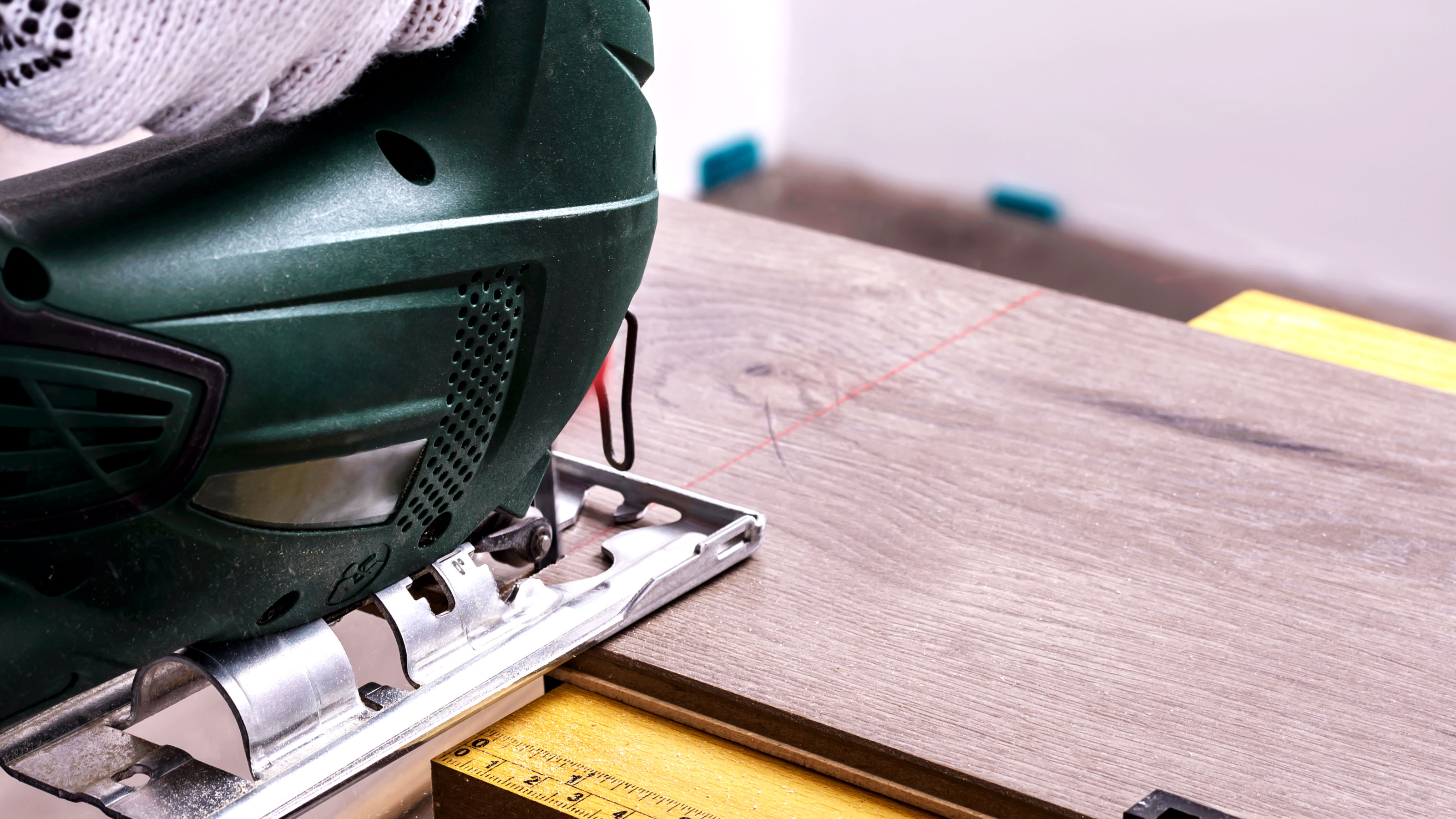How to cut laminate flooring: The tools and techniques to get the job done
Learning how to cut laminate flooring is an essential skill for a DIYer. Here we reveal what you’ll need to make cuts for corners, curves and any other shapes

You’ll need to know how to cut laminate flooring if you want a perfect fit for your new floor. Getting it right is essential. Get it wrong and you could be left short on length or width, or with an ugly angled cut that just doesn’t sit right. This means you will need another length of laminate to fix what could be an expensive mistake.
Getting the cut right is an essential part of how to lay laminate flooring the right way. A poor cut can leave ugly chipped edges, which no-one wants to see. But, even worse you can produce the perfect cut and then find you haven’t accounted for an expansion gap. So you’ll need to make sure that you measure up properly before you cut.
Here we give you the lowdown on what type of saw you need and other tools for the job to get the right cut for your laminate flooring.
How to cut laminate flooring: What tools will I need?
Before you start you need to know how to measure up for laminate flooring and make sure that you have the right tools in place.
- Dust mask
- Dust sheets
- Pencil or chalk
- Tape measure
- Saw
What type of saw do I need?
There are a number of different saws that you can use to cut laminate flooring. If you have a hand saw or mitre hand saw handy use these. Alternatively, you can invest in a power saw such as a jigsaw or mitre saw. Here we take a look at each option.
Hand saw
A standard hand saw is a good all round choice if you don’t want to invest in a more expensive power saw. It's good for cutting across the width and length of a laminate plank. But you will need to make sure you have a fine tooth hand saw with at least 15 teeth per inch (tpi) to make sure that the edge of the cut isn’t chipped.
When using a hand saw, safely place your thumbnail adjacent to the blade where you want the cut and draw back the saw a few times to create a guide for cutting. Once done use the common back and forth sawing motion.
Mitre saw
The best mitre saws are a top tool for getting clean accurate cuts on laminate flooring. It is self contained, has its own surface to keep a plank steady and is great for getting accurate angles.
However, it only has a small cutting surface, so it is only really good for cutting the width of a laminate plank. To cut, power up the blade before slowly pulling down the blade to make the cut.
A powered alternative if you need to cut lengthways is a circular saw or a table saw, but neither are cheap.
Jigsaw
A jigsaw is an all-rounder when it comes to laminate flooring, however it does rely on a steady hand from the user to get a long straight line. That said, it is great for cutting unusual shapes and around pipes.
To get a decent cut you will need a fine tooth blade and like most power tools get the blade running before you start cutting.
Once you have made your cuts, find out how to lay your laminate flooring with our DIY video guide…
Should I cut laminate flooring upside down?
Typically you should cut laminate flooring with the laminate – the bit you will see when laid – facing you. This will give you a nice clean cut, but make sure that you have a fine tooth blade to get the best finish.
If you are unsure that your saw is suitable for the job, do a practice run before you start.
How do I cut laminate flooring without chipping it?
Whatever saw you use it will need to have plenty of teeth to help ensure that you get a crisp cut. If using a hand saw make sure it has at least 15 tpi (teeth per inch). The more teeth per inch means a finer cut.
If using a jigsaw you want to be using a blade that has 30 teeth or more. For a powered mitre saw look for a blade with 80-100 teeth to get a decent cut.
Do you cut the tongue off the first row of laminate?
You will need to leave an expansion gap all the way around a room when laying laminate flooring. So when you are placing a plank end against a skirting board you need to cut off the tongue to make sure you get the right expansion gap.
If you leave the tongue on this will leave a big gap between the end of the plank and skirting which will be difficult to hide. To do this, simply do a straight cut as close to the end of the plank as possible to remove the tongue.
If you are unsure about laying laminate flooring – i.e. in high moisture areas like a bathroom – consider the pros and cons of laminate vs vinyl flooring to help you make up your mind.
Get the Homebuilding & Renovating Newsletter
Bring your dream home to life with expert advice, how to guides and design inspiration. Sign up for our newsletter and get two free tickets to a Homebuilding & Renovating Show near you.
Steve Jenkins is a freelance content creator with over two decades of experience working in digital and print and was previously the DIY content editor for Homebuilding & Renovating.
He is a keen DIYer with over 20 years of experience in transforming and renovating the many homes he has lived in. He specialises in painting and decorating, but has a wide range of skills gleaned from working in the building trade for around 10 years and spending time at night school learning how to plaster and plumb.
He has fitted kitchens, tiled bathrooms and kitchens, laid many floors, built partition walls, plastered walls, plumbed in bathrooms, worked on loft conversions and much more. And when he's not sure how to tackle a DIY project he has a wide network of friends – including plumbers, gas engineers, tilers, carpenters, painters and decorators, electricians and builders – in the trade to call upon.

